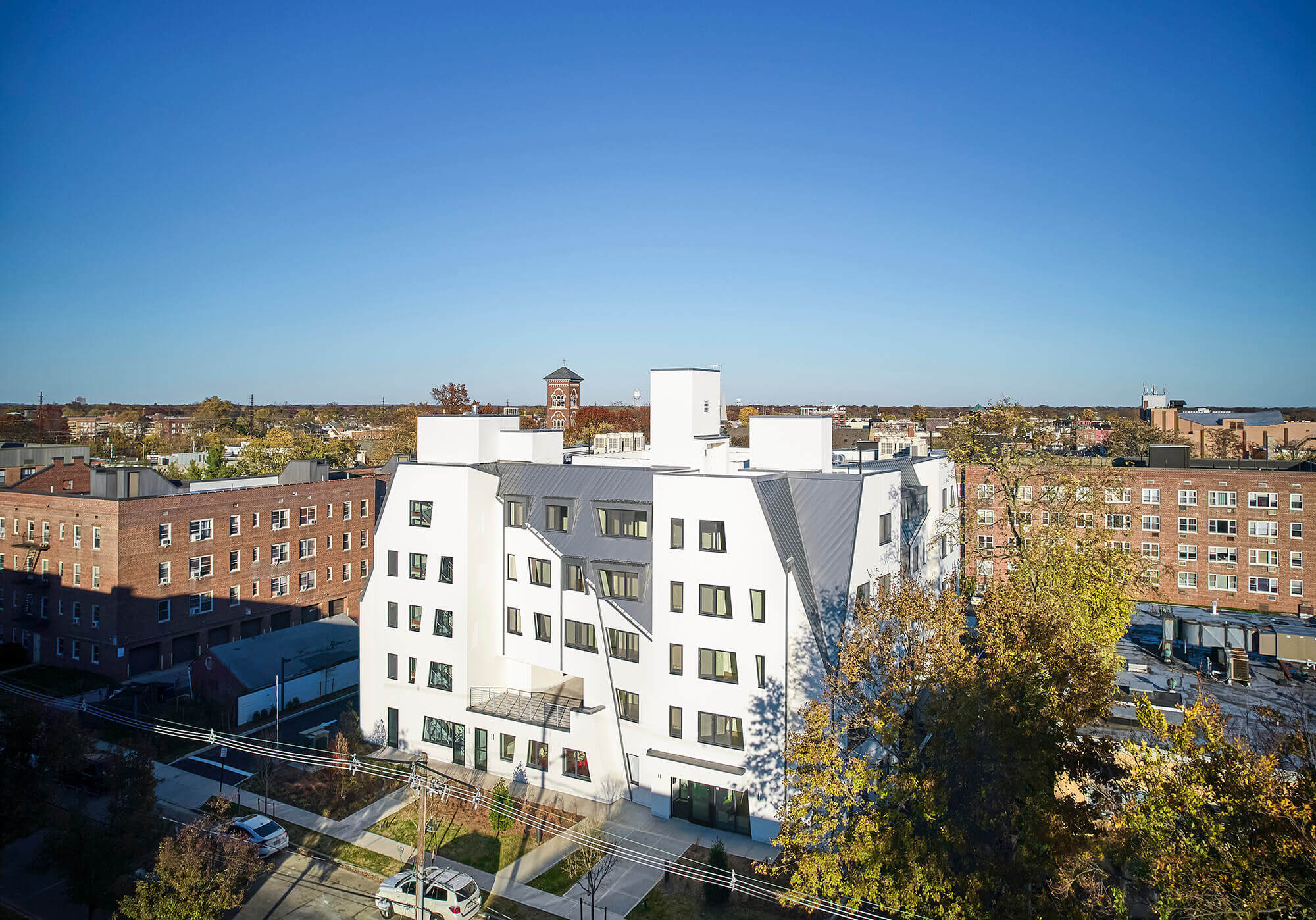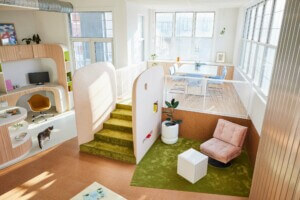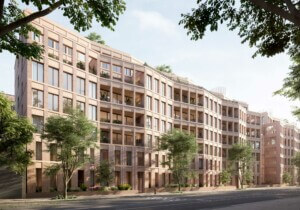Since 1989, Daniel Libeskind has built a reputation for designing landmark cultural spaces around the world. His office, Studio Libeskind, boasts a portfolio that includes the Jewish Museum in Berlin, the World Trade Center Master Plan in Lower Manhattan, the Royal Ontario Museum in Toronto, and much more. Recently, he partnered with families of mass-shooting victims in Pittsburgh to design an outdoor memorial and a reimagined center to combat anti-Semitism at the Tree of Life Synagogue.
Today, Libeskind is working on projects most people don’t associate with architects of his caliber: social housing. Studio Libeskind’s Allan & Geraldine Rosenberg Residences opened in Freeport, Long Island last September. There, 45 artfully crafted units deliver much-needed housing for formerly homeless people and low-income seniors. Studio Libeskind’s Atrium at Sumner, another social housing project, is slated to open early this year in Bedford-Stuyvesant, Brooklyn.
Studio Libeskind relocated from Berlin to Manhattan in 2003, but the Rosenberg Residences mark the office’s first building in New York. AN interviewed Daniel Libeskind about these two social housing projects, and why he’s so passionate about them.

AN: You grew up in a Bronx co-op. How did that shape your views about architecture?
Daniel Libeskind (DL): I come from a family of Polish immigrants, and my parents were factory workers. When we moved to the U.S. we lived in the country’s first cooperative housing estate, Amalgamated Houses, built by the [International Ladies] Garment Workers Union in the Bronx.
There’s a film called The Garment Jungle which showed the blight that workers and unions used to face. Our [cooperative] by the garment workers union was beautiful. It was a wonderful place to come to as an immigrant teenager. We had a small apartment—it was four of us in a two-room walkup—but we had a community. We had a library, and we had shared space where Yiddish poets would lecture. It was here where my belief formed that social cooperative housing really creates communities.
I revisited my old house in the Bronx recently, actually, for a film shoot. It’s still so beautiful. The fact that this quality of life at Amalgamated Houses was affordable to working people like us expanded my own understanding of architecture beyond what buildings look like, but also into the matters of ethics and politics.
AN: How did your upbringing inspire you to build supportive housing today?
DL: So often, well-known architects become famous for grand buildings like museums, but we really need to change this. We need more great architects designing public housing, and we need to remove the stigma behind public housing. Cities are often judged by how fancy their museums are, but really they should be judged by how they house the working class.
Today, there’s simply not enough housing for working class and low income people. That, paired with my own childhood, is why we entered two competitions to design supportive housing in Long Island and Bedford-Stuyvesant.
Atrium at Sumner in Brooklyn and [Rosenberg Residences] in Long Island are in collaboration with Selfhelp, an organization that was started during the Holocaust to help people move to New York. In those days, Selfhelp was mostly helping Jewish people find housing, and today they mostly serve people from Asia and Latin America. Their demographic has changed but their mission is still the same: Connect people to good housing. I think it’s a remarkable organization. So both projects in Brooklyn and Long Island are so close to my heart.
AN: What was your approach for designing the Rosenberg Residences?
DL: When we designed Rosenberg Residences, I had a simple goal. I wanted to design a place where I would want to live. More broadly, I wanted to show architects that it’s possible to make good housing for the homeless and working people within very limited means.
Aesthetically, I wanted to make something that fit into the community that was also different from the housing around it. I wanted to make a building that spoke to the people who lived there. So it’s kind of vernacular, and fits into domestic life nicely, but has spectacular spaces with unique views. The building changes the character of the street itself.
At the opening ceremony, a woman who had been homeless before moving into the building spoke. She talked about how she had lived in her car. At the opening, she said when she walked into her new house, she couldn’t believe it was for her. She had a bed, a kitchen, things that many take for granted. I think this kind of work is exemplary, and more architects should be doing it.

AN: Can you talk about the design for Atrium at Sumner?
DL: The site in Brooklyn faces Sumner Houses, which are box-shaped buildings that don’t really have a relationship with the street. Our goal was to create a beautiful environment in a changing neighborhood. So we designed an atrium that’s a social space, a clinic, space for lectures and performance, and so forth. Just like what I had growing up in the Bronx.
When we’d visit the site in Bed-Stuy, people would stop us on the street and ask if the building was a condo for rich people. We’d say: No, it’s for low-income and formerly homeless seniors. The community really appreciated the quality of the design.
AN: There are so many obstacles that exist in the U.S. to building more public housing. What needs to happen to change that?
DL: I live part-time in Berlin, and even people there are protesting. They can’t afford rent either, so it’s a global crisis. Government and private groups should realize that everyone benefits when a city has housing for everyone. It needs to be easier for philanthropic organizations and developers to build public housing, and make a living that way. Today, I have great admiration for NYCHA. They’ve raised their aspirations by investing in really great architecture and urban landscapes for people to have good lives.
I think, also, it’s important to remove the stigma surrounding social housing. When Rosenberg Residences opened in Long Island, someone said to me that they were surprised a well-known architect wanted to design social housing. But that’s exactly why I did it! I wanted to raise the bar and show architects that we need to do more of this.











